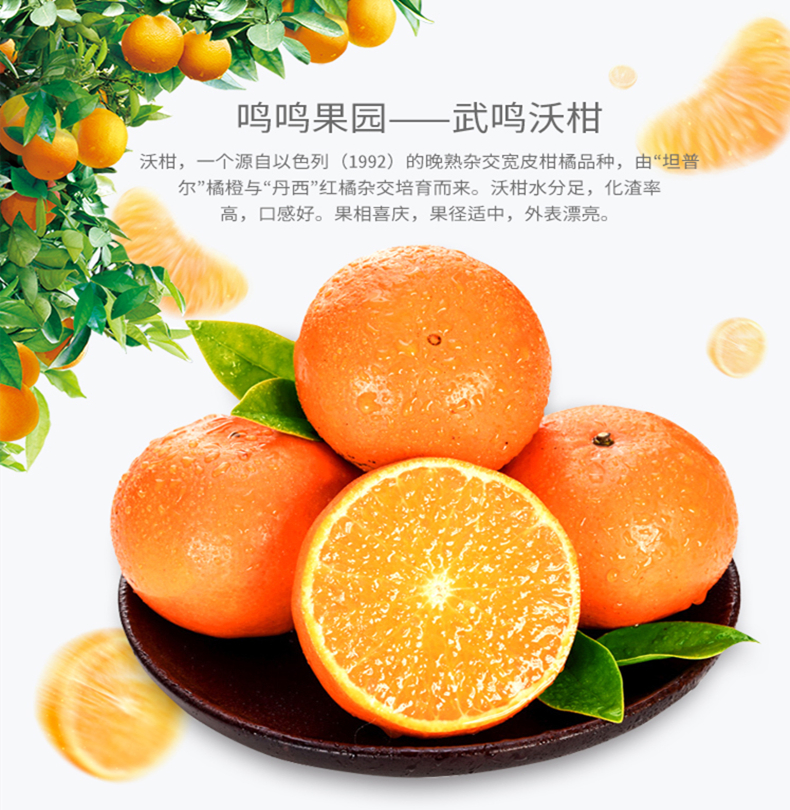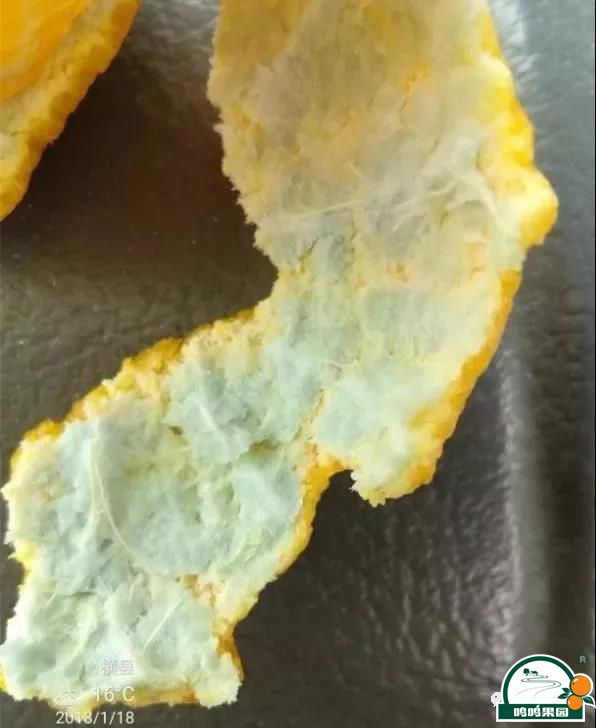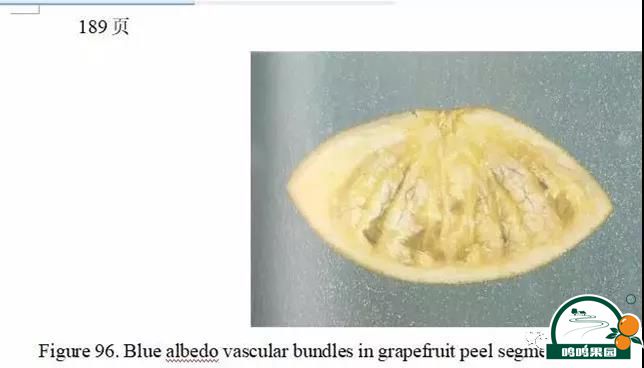
柑橘白皮层蓝变有结论了
2018-04-13 15:12:00 来源:鸣鸣果园 点击:
摘要:白皮层蓝变,外国人对此早有观察,并在《佛罗里达柑橘诊断指南》有介绍,介绍的情况和我们观察到的情况符合。

白皮层蓝变,外国人对此早有观察,并在《佛罗里达柑橘诊断指南》有介绍,介绍的情况和我们观察到的情况符合。

Blue albedo is a condition where the albedo (white portion of the peel), and sometimes the vascular bundles, segment walls and occasionally juice sacs, have a distinct light blue color. The discoloration can vary from distinct vascular bundle patterns (Fig. 96) to an overall bluish color in the albedo. This condition has been observed in fruit from Arizona, Florida, California and Texas. As early as 1944 blue albedo was reported to be associated with stubborn disease. It has also been reported to be more prevalent when excessive fertilization or high salt content of shallow soils damage the roots.
In Florida this disorder has been seen in oranges, tangelos and especially grapefruit. Blue albedo is reported nearly every season, and is found frequently in some seasons. Consumers occasionally report this disorder as an alarming observation.
Blue albedo is nearly always reported in seasons with excessive rainfall, and the fruit is usually from groves with marginal water drainage. Trees under stress from excessive water may produce fruit with blue albedo. The blue color is a naturally occurring water soluble pigment, probably an anthocyanin similar to those found in blueberries and sweet cherries. The color persists in fresh fruit held at 4.4°C (40°F) and 21.1°C (70°F), but gradually fades in 3 weeks from chilled sections held at 4.4°C (40°F).
Control is effected through careful management. Avoiding excessive fertilization of shallow soil groves and selecting well drained groves for fresh fruit marketing in seasons with excessive rainfall will minimize the problem.
(李曦翻译)
Blue albedo is a condition where the albedo (white portion of the peel), and sometimes the vascular bundles, segment walls and occasionally juice sacs, have a distinct light blue color.
蓝色的内果皮,柑橘的内果皮(剥皮后果皮的白色部分),维管束,橘瓣膜,偶尔汁囊有轻微的淡蓝色。The discoloration can vary from distinct vascular bundle patterns (Fig. 96) to an overall bluish color in the albedo.
这个变色会出现在维管束的部分,甚至到整个内果皮都是蓝色。
This condition has been observed in fruit from Arizona, Florida, California and Texas.这种情况在亚利桑那州、佛罗里达州、加利福尼亚州和得克萨斯州都有观察到。
As early as 1944 blue albedo was reported to be associated with stubborn disease. 早在1944年,就有报道说蓝色的内果皮是顽固的病害。
It has also been reported to be more prevalent when excessive fertilization or high salt content of shallow soils damage the roots.
报道中提出,当施肥过多或浅层土壤含盐量过高损害根系时,这种现象普遍存在。
In Florida this disorder has been seen in oranges, tangelos and especially grapefruit. 在佛罗里达,这种症状在橙子、橘柚,尤其是葡萄柚中有发生。
Blue albedo is reported nearly every season, and is found frequently in some seasons. 几乎在每一个季节都有报道,而且在某些季节经常出现。Consumers occasionally report this disorder as an alarming observation.消费者偶尔会报道这个现象,作为一种令人担忧的现象。
Blue albedo is nearly always reported in seasons with excessive rainfall, and the fruit is usually from groves with marginal water drainage.
它被报道出现在雨量过多的季节,并且出现在位于果园排水沟边缘处的果实上。
Trees under stress from excessive water may produce fruit with blue albedo.
果树受到水分果多的胁迫后会出现这种现象。The blue color is a naturally occurring water soluble pigment, probably an anthocyanin similar to those found in blueberries and sweet cherries.这个蓝色是天然的水溶性染料,它与蓝莓和樱桃中的花青素相似。 The color persists in fresh fruit held at 4.4°C (40°F) and 21.1°C (70°F), but gradually fades in 3 weeks from chilled sections held at 4.4°C (40°F).这个蓝色出现在4.4℃和21℃的鲜果中,但在冰冻的切片中,在4.4℃三周内会褪色。
Control is effected through careful management. 通过管理会控制它的发生。Avoiding excessive fertilization of shallow soil groves and selecting well drained groves for fresh fruit marketing in seasons with excessive rainfall will minimize the problem.避免浅层土壤的过度施肥,选择排水良好的地域避免在雨量大的季节积水,这些方法可以减少蓝色内果皮的发生。







